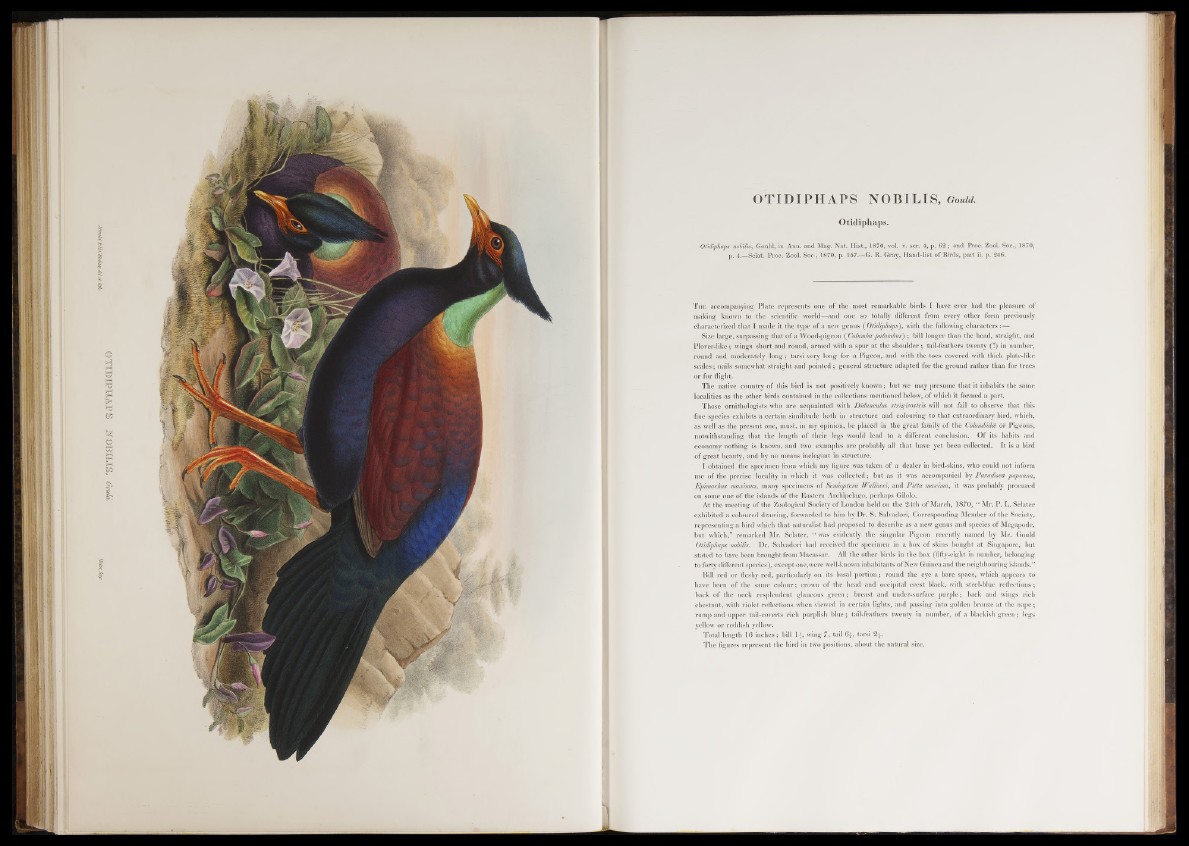
OTIDIPHAPS NOBILIS, Gould.
Otidiphaps.
Otidiphaps nobilis, Gould, in Ann. and Mag. Nat. Hist., 1870, vol. v. ser. 4, p. 6 2 ; and Proc. Zool. Soc., 1870,
p. 4.—Sclat. Proc. Zool. S o c , 1870, p, 157.—G. R. Gray, Hand-list o f Birds, part ii. p. 246.
T he accompanying Plate represents one of the most remarkable birds I have ever had the pleasure of
making known to the scientific world— and one so totally different from every other form previously
characterized that I made it the type o f a new genus ( Otidiphaps) , with the following characters: —
Size large, surpassing that of a Wood-pigeon ( Columha palumbus) ; bill longer than the head, straight, and
Plover-like; wings short and round, armed with a spur at the shoulder; tail-feathers twenty (!) in number,
round and moderately long; tarsi very long for a Pigeon, and with the toes covered with thick plate-like
scales; nails somewhat straight and pointed; general structure adapted for the ground rather than for trees
or for flight*
The native country o f this bird is not positively known; but we may presume that it inhabits the same
localities as the other birds contained in the collections mentioned below, o f which it formed a part.
Those ornithologists who are acquainted with Didunculus strigirostm will not fail to observe that this
fine species exhibits a certain similitude both in structure and colouring to that extraordinary bird, which,
as well as the present one, must, in my opinion, be placed in the great family of the Columbidce or Pigeons,
notwithstanding that the length of their legs would lead to a different conclusion. Of its habits and
economy nothing is known, and two examples are probably all that have yet been collected. It is a bird
o f great beauty, and by no means inelegant in structure.
I obtained the specimen from which my figure was taken of a dealer in bird-skins, who could not inform
me of the precise locality in which it was collected; but as it was accompanied by Paradisea papuana,
Epimaclm maximus, many specimens of Semioptera Wallacei, and P itta maxima, it was probably procured
on some one of the islands of the Eastern Archipelago, perhaps Gilolo.
At the meeting of the Zoological Society o f London held on the 24th of March, 1870, “ Mr. P. L. Sclater
exhibited a coloured drawing, forwarded to him by Dr. S. Salvadori, Corresponding Member o f the Society,
representing a bird which that naturalist had proposed to describe as a new genus and species of Megapode,
but which,” remarked Mr. Sclater, “ was evidently the singular Pigeon recently named by Mr. Gould
Otidiphaps nobilis. Dr. Salvadori had received the specimen in a box of skins bought at Singapore, but
stated to have been brought from Macassar. All the other birds in the box (fifty-eight in number, belonging
to forty different species), except one, were well-known inhabitants o f New Guinea and the neighbouring islands.”
Bill red or fleshy red, particularly on its basal portion; round the eye a bare space, which appears to
have been of the same colour; crown of the head and occipital crest black, with steel-blue reflections;
back of the neck resplendent glaucous green; breast and under-surface purple; back and wings rich
chestnut, with violet reflections when viewed in certain lights, and passing into golden bronze at the nape;
rump and upper tail-coverts rich purplish blue; tail-feathers twenty in number, of a blackish green; legs
yellow or reddish yellow.
Total length 16 inches; bill IT, wing 7, tail 6 f, tarsi 2|..
The figures represent the bird in two positions, about the natural size.